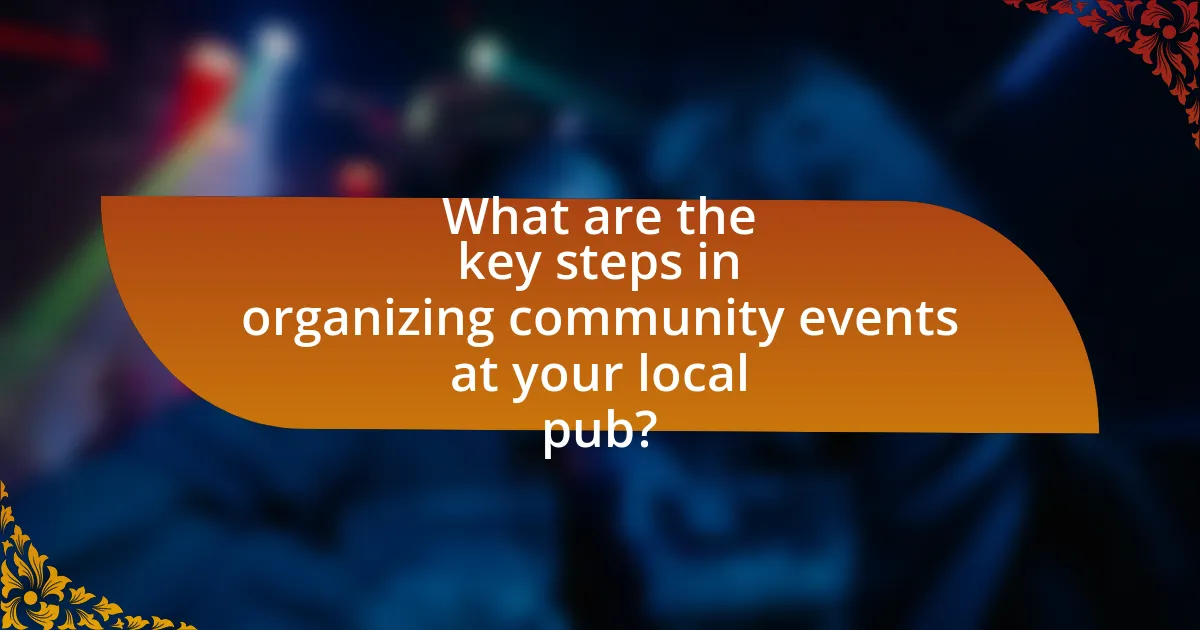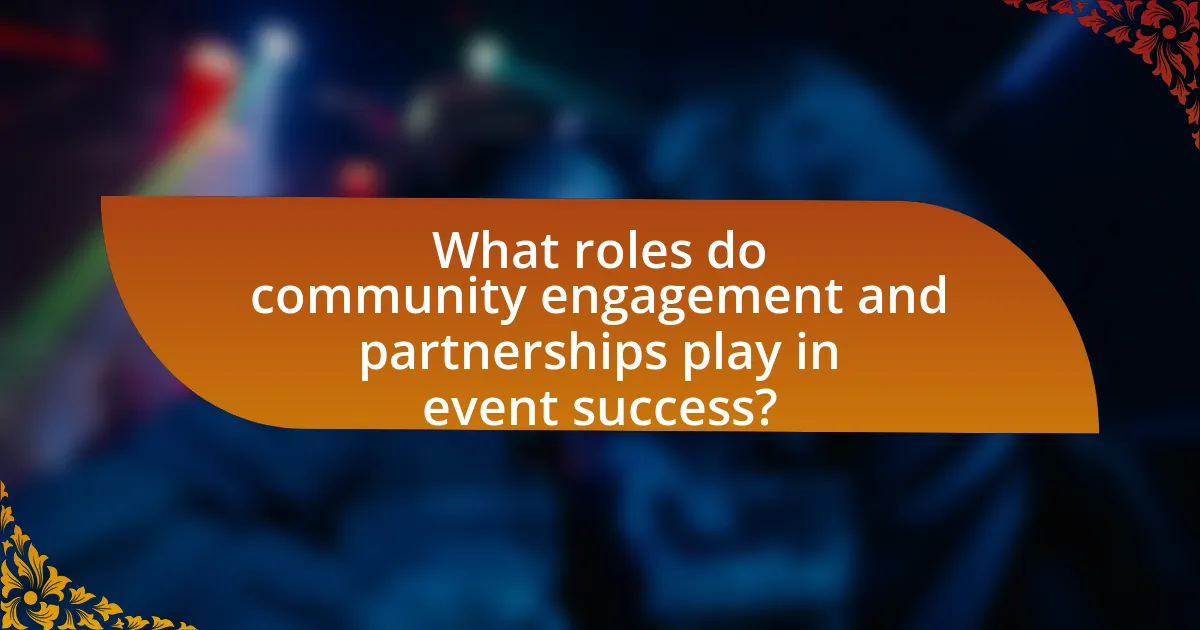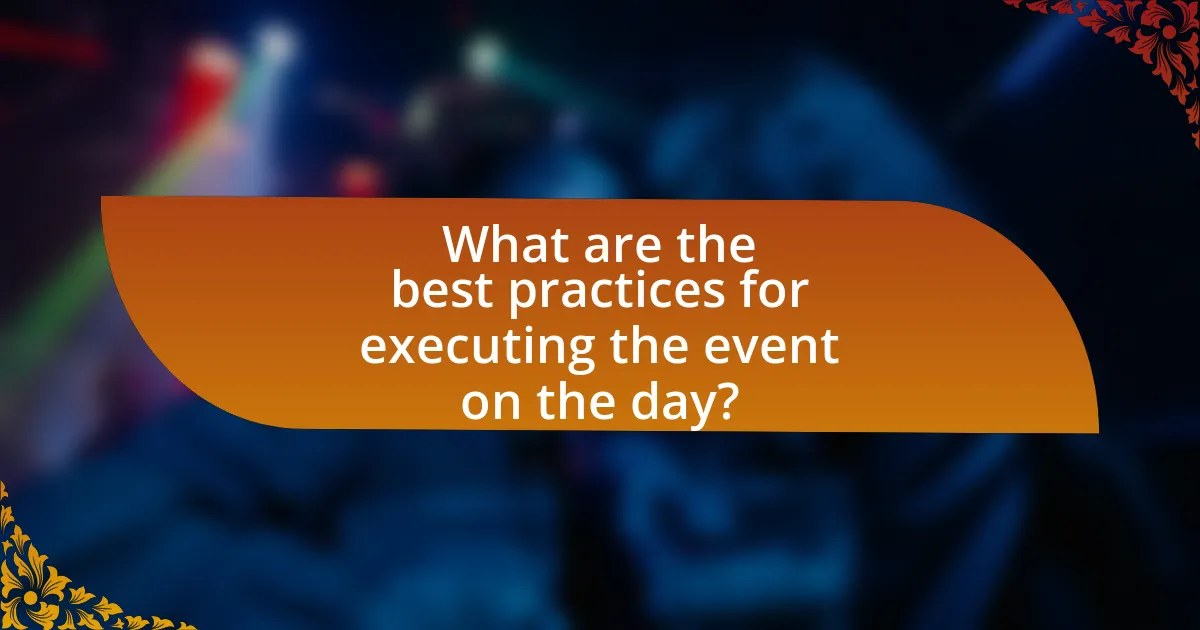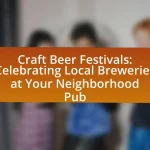The article focuses on the essential steps for organizing community events at local pubs, emphasizing the importance of defining the event’s purpose, selecting appropriate dates, promoting effectively, coordinating logistics, and evaluating success. Key considerations include understanding community interests, logistical arrangements, and the role of partnerships with local businesses. The article also highlights strategies for enhancing community participation, managing event execution, and gathering feedback post-event to inform future planning. Overall, it serves as a comprehensive guide for successfully engaging local communities through well-organized events.

What are the key steps in organizing community events at your local pub?
The key steps in organizing community events at your local pub include defining the event’s purpose, selecting a date and time, promoting the event, coordinating logistics, and evaluating the event’s success. First, defining the event’s purpose helps to clarify the goals, whether it’s to raise funds, foster community engagement, or celebrate a local holiday. Next, selecting a date and time that does not conflict with other local events ensures better attendance. Promoting the event through social media, local flyers, and word-of-mouth increases visibility and interest. Coordinating logistics involves arranging seating, food and drink options, entertainment, and any necessary permits. Finally, evaluating the event’s success through feedback and attendance metrics helps to inform future events and improve planning processes.
How do you identify the purpose of the event?
To identify the purpose of the event, start by defining the goals you want to achieve, such as community engagement, fundraising, or entertainment. This clarity helps in aligning the event’s activities and messaging with the intended outcomes. For instance, if the goal is to raise funds for a local charity, the event should include activities that promote donations, such as auctions or donation drives. Additionally, gathering input from potential attendees can provide insights into their interests and expectations, further refining the event’s purpose.
What factors should you consider when defining the event’s goals?
When defining the event’s goals, consider the target audience, desired outcomes, available resources, and the overall theme of the event. The target audience influences the type of activities and messaging that will resonate, while desired outcomes clarify what success looks like, such as increased community engagement or revenue generation. Available resources, including budget and staff, determine the feasibility of achieving these goals. Lastly, aligning the goals with the event’s theme ensures coherence and enhances attendee experience. These factors collectively guide the planning process and help measure the event’s success effectively.
How can you align the event’s purpose with community interests?
To align the event’s purpose with community interests, conduct thorough research to understand the specific needs and preferences of the community. Engaging with local residents through surveys or focus groups can reveal their interests, ensuring the event resonates with them. For instance, a study by the National Endowment for the Arts found that community engagement in event planning increases attendance and satisfaction rates. By incorporating feedback and tailoring the event’s activities to reflect community values, organizers can create a meaningful experience that fosters participation and support.
What are the essential logistical considerations?
The essential logistical considerations for organizing community events at a local pub include venue capacity, scheduling, resource allocation, and compliance with regulations. Venue capacity determines how many attendees can be accommodated, which directly impacts event planning and safety measures. Scheduling involves selecting appropriate dates and times that maximize attendance while avoiding conflicts with other local events. Resource allocation encompasses the management of staff, equipment, and supplies necessary for the event, ensuring that everything is available and functioning. Compliance with regulations includes obtaining necessary permits and adhering to health and safety standards, which is crucial for legal operation and community trust.
How do you choose the right date and time for the event?
To choose the right date and time for the event, analyze the availability of your target audience and consider local calendars. Selecting a date that avoids major holidays or community events increases attendance; for instance, a study by Eventbrite shows that events scheduled on weekdays often attract fewer participants compared to weekends. Additionally, conducting a survey among potential attendees can provide insights into their preferred times, ensuring the event aligns with their schedules.
What venue arrangements need to be made at the pub?
Venue arrangements at the pub include reserving a designated area for the event, ensuring adequate seating and table arrangements, and confirming availability of necessary equipment such as audio-visual systems. Additionally, it is essential to coordinate with the pub staff regarding catering options, bar service, and any special requests for decorations or themes. These arrangements are crucial for accommodating the expected number of attendees and ensuring a smooth event experience.
How can you effectively promote the event?
To effectively promote the event, utilize a multi-channel marketing strategy that includes social media, email newsletters, and local partnerships. Social media platforms like Facebook and Instagram allow for targeted advertising and event pages, reaching a wider audience. Email newsletters can inform existing customers about the event, encouraging attendance through exclusive offers. Collaborating with local businesses or influencers can enhance visibility and credibility, as they can share the event with their networks. According to a study by Eventbrite, 80% of event attendees discover events through social media, highlighting its effectiveness as a promotional tool.
What marketing channels are most effective for local events?
Social media platforms, local community boards, and email marketing are the most effective marketing channels for local events. Social media allows for targeted advertising and engagement with local audiences, as platforms like Facebook and Instagram have features specifically designed for event promotion. Local community boards, both online and offline, provide a space for event announcements and foster community engagement. Email marketing enables direct communication with interested attendees, allowing for personalized invitations and updates. According to a study by Eventbrite, 80% of event organizers find social media to be the most effective channel for promoting local events, highlighting its significance in reaching local audiences.
How can social media be leveraged for event promotion?
Social media can be leveraged for event promotion by creating targeted campaigns that engage potential attendees and build community interest. Utilizing platforms like Facebook, Instagram, and Twitter allows event organizers to share event details, create event pages, and use targeted ads to reach specific demographics. According to a study by Eventbrite, 93% of event creators use social media to promote their events, highlighting its effectiveness in reaching a wider audience. Engaging content such as videos, live streams, and interactive posts can further enhance visibility and encourage sharing, leading to increased attendance.

What roles do community engagement and partnerships play in event success?
Community engagement and partnerships are crucial for event success as they foster local support and enhance resource availability. Engaging the community creates a sense of ownership and encourages participation, which can lead to higher attendance and enthusiasm for the event. Partnerships with local businesses and organizations can provide additional resources, such as funding, venues, or promotional support, which can significantly improve the event’s reach and impact. For instance, a study by the National Endowment for the Arts found that events with strong community ties saw a 30% increase in attendance compared to those without such connections. This demonstrates that effective community engagement and strategic partnerships directly contribute to the overall success of events.
How can you involve local businesses and organizations?
To involve local businesses and organizations, establish partnerships that create mutual benefits, such as co-hosting events or offering sponsorship opportunities. Collaborating with local businesses can enhance event visibility and attract a larger audience, as evidenced by a study from the National Federation of Independent Business, which found that 70% of consumers prefer to support local businesses. Additionally, engaging organizations can provide resources, volunteers, and promotional support, further enriching the community event experience.
What benefits do partnerships bring to community events?
Partnerships enhance community events by providing increased resources, expertise, and outreach capabilities. Collaborating with local businesses, organizations, or community groups allows event organizers to pool financial support, share promotional efforts, and access specialized skills or knowledge. For instance, a partnership with a local charity can attract more attendees and foster goodwill, while collaboration with a media outlet can amplify event visibility. Research indicates that events with multiple partners often experience higher attendance rates and greater community engagement, demonstrating the tangible benefits of such collaborations.
How can you approach potential partners for collaboration?
To approach potential partners for collaboration, initiate contact through a well-crafted proposal that outlines mutual benefits and shared goals. This proposal should clearly define the objectives of the collaboration, the roles of each partner, and the expected outcomes. Research shows that partnerships with clear, defined goals lead to a 30% higher success rate in community initiatives, as evidenced by studies from the Community Development Society. Engaging potential partners in a conversation about their interests and how they align with your event can further strengthen the collaboration.
What strategies can enhance community participation?
To enhance community participation, implementing inclusive planning processes is essential. Engaging community members in the decision-making stages fosters a sense of ownership and investment in local events. Research indicates that when individuals feel their voices are heard, participation rates increase significantly; for instance, a study by the National Civic League found that communities with participatory planning saw a 30% rise in event attendance. Additionally, utilizing social media platforms for outreach and feedback can effectively reach diverse demographics, ensuring broader engagement.
How can you gather feedback from the community before the event?
To gather feedback from the community before the event, utilize surveys and social media polls to directly engage with potential attendees. Surveys can be distributed via email or community platforms, allowing participants to express their preferences regarding event details such as timing, activities, and themes. Social media polls on platforms like Facebook or Instagram can quickly gauge interest and gather opinions from a broader audience. Research indicates that 70% of consumers prefer to provide feedback through online surveys, highlighting their effectiveness in collecting community insights.
What incentives can encourage attendance and participation?
Incentives that can encourage attendance and participation include offering discounts, providing free refreshments, and organizing engaging activities. Discounts on food and drinks can attract more attendees, as evidenced by a study from the Journal of Marketing Research, which found that promotional pricing increases customer turnout by 20%. Free refreshments create a welcoming atmosphere, encouraging social interaction and participation. Additionally, engaging activities such as games or live music can enhance the overall experience, leading to higher attendance rates, as shown in community event surveys indicating that interactive elements significantly boost participation.

What are the best practices for executing the event on the day?
The best practices for executing the event on the day include thorough preparation, effective communication, and proactive problem-solving. Event organizers should ensure that all logistical elements, such as seating arrangements, sound systems, and catering, are set up well in advance. Effective communication among team members is crucial; assigning specific roles and responsibilities helps streamline operations. Additionally, being prepared for unexpected issues, such as technical difficulties or last-minute changes, allows for quick resolutions, ensuring a smooth experience for attendees. These practices are supported by event management studies that emphasize the importance of planning and adaptability in successful event execution.
How do you ensure smooth event operations?
To ensure smooth event operations, meticulous planning and coordination are essential. This involves creating a detailed event timeline, assigning specific roles to team members, and establishing clear communication channels. For instance, a study by the Event Management Institute found that 70% of successful events attribute their success to thorough pre-event planning and effective team collaboration. By implementing these strategies, potential issues can be identified and addressed proactively, leading to a seamless event experience.
What roles should volunteers and staff play during the event?
Volunteers and staff should play distinct yet complementary roles during the event to ensure its success. Staff members typically handle logistical tasks such as setup, coordination, and management of resources, while volunteers engage directly with attendees, providing assistance, information, and support. For instance, staff may oversee the schedule and ensure that activities run smoothly, while volunteers can facilitate interactions and enhance the overall experience for participants. This division of responsibilities allows for efficient event execution and fosters a welcoming atmosphere, which is crucial for community engagement.
How can you manage unexpected challenges during the event?
To manage unexpected challenges during the event, implement a proactive contingency plan that includes identifying potential risks and establishing clear protocols for various scenarios. This approach allows event organizers to respond swiftly and effectively to issues such as equipment failure, weather changes, or low attendance. For instance, having backup equipment readily available and a communication plan for staff can significantly mitigate disruptions. Research indicates that events with contingency plans experience 30% fewer disruptions, highlighting the importance of preparation in ensuring a smooth event.
What post-event activities are important for future success?
Post-event activities crucial for future success include gathering feedback, analyzing event performance, and maintaining engagement with attendees. Gathering feedback through surveys or direct communication helps identify strengths and areas for improvement, which is essential for refining future events. Analyzing performance metrics, such as attendance numbers and participant engagement levels, provides insights into what worked well and what did not, allowing for data-driven decisions in planning future events. Maintaining engagement with attendees through follow-up communications, such as thank-you emails or newsletters, fosters community relationships and encourages repeat participation. These activities collectively enhance the effectiveness of future events and contribute to sustained community interest and involvement.
How can you gather feedback from attendees after the event?
To gather feedback from attendees after the event, utilize post-event surveys distributed via email or online platforms. Surveys can include multiple-choice questions, open-ended responses, and rating scales to assess various aspects of the event, such as organization, content, and overall satisfaction. Research indicates that 70% of event organizers use surveys to collect feedback, highlighting their effectiveness in capturing attendee insights. Additionally, offering incentives for completing the survey can increase response rates, ensuring a more comprehensive understanding of attendee experiences.
What steps should you take to evaluate the event’s success?
To evaluate the event’s success, first, establish clear objectives and key performance indicators (KPIs) before the event. These KPIs may include attendance numbers, participant satisfaction ratings, and revenue generated. After the event, collect data through surveys, attendance records, and financial reports to measure these KPIs against the initial objectives. For instance, if the goal was to attract 100 attendees and the actual count was 120, this indicates a successful turnout. Additionally, analyze qualitative feedback from participants to assess their experience and identify areas for improvement. This structured approach ensures a comprehensive evaluation of the event’s success based on predefined criteria.
What are some practical tips for organizing successful community events at your local pub?
To organize successful community events at your local pub, start by defining a clear purpose for the event, such as fostering community engagement or supporting a local charity. Next, select a suitable date and time that does not conflict with other local events, ensuring maximum attendance. Promote the event through social media, local flyers, and word of mouth to reach a wider audience. Collaborate with local businesses for sponsorships or partnerships, which can enhance the event’s appeal and reduce costs. Finally, gather feedback after the event to assess its success and identify areas for improvement, as community input is crucial for future planning.

